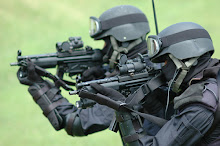









The Kommando Spezialkräfte (Special Forces Command, KSK) is part of Germany's Special Forces. Organized under the Special Operations Division (Div. Spezielle Operationen, DSO), it is closely modeled on the British Special Air Service (SAS).History
Prior to KSK’s formation in 1996, Germany, and before it West Germany, placed little emphasis on special operations beyond the counter-terrorist police unit GSG 9. At the time, the airborne brigade commandos and Fernspäher companies were the only army units comparable to Special Forces (the navy already had its Kampfschwimmer company for years). All the early specialised army units except for one Fernspähkompanie have been disbanded or merged into the KSK since its activation on April 1, 1997.
Like all German military units, KSK deployment requires parliamentary authorization, providing evidence of operations in Kosovo, Bosnia and Herzegovina and Afghanistan. Specific operational details, such as success or casualty rates, are top secret and withheld even from members of parliament. This practice drew heavy criticism, resulting in plans to increase transparency and accountability by relaying mission details to selected members of the Bundestag.
Structure
The fighting units are divided into four commando companies of about 100 men each and the special commando company with veteran members, taking supporting tasks. Each of the four commando companies has five specialized platoons:
* 1st platoon: land insertions
* 2nd platoon: airborne operations
* 3rd platoon: amphibious operations
* 4th platoon: operations in special geographic or meteorological surroundings (e.g. mountains or polar regions)
* 5th platoon: reconnaissance, sniper and counter-sniper operations
* Command Platoon
There are four commando squads in every platoon. Each of these groups consists of about four equally skilled soldiers. One of each group is specially trained as weapons expert, medic, combat engineer or communications expert respectively. Additionally a group can contain other specialists, e.g. heavy weapons or language experts.
Selection and training
Initially, only officers and non-commissioned officers of the Bundeswehr could apply to the KSK. The basic Bundeswehr Commando course ("Einzelkämpferlehrgang") was a prerequisite for application. Since 2005, application is also open for civilians and enlisted personnel, who have to complete an 18-month Long Range Surveillance training before the KSK selection phases.
The selection is divided into two phases, a three-week-long first phase with a fitness and psychological test (about 50% pass rate) and a three-month-long second phase testing physical endurance (8 - 10% pass rate). The KSK use the Black Forest as a testing area for this phase. In this time the candidates must undergo a 90-hour long distance cross-country run. Then they have to go through a three week international survival, escape and evasion course called Combat Survival Course at the German Special Operations Training Centre (formerly the International Long Range Reconnaissance School) in Pfullendorf.
If candidates have passed these tests, they can begin their 2 to 3 year training in the KSK. This training includes about 20 Jungle, Desert, Urban and Counter-terrorism specialist courses at over 17 schools worldwide, e.g. in Norway (Arctic), Austria (Mountains), El Paso/Texas or Israel (Desert), San Diego (Water) or Belize (Jungle).
According to press releases from May 2008, the Bundeswehr aims to advance the attractivity of service in the KSK to women[1]. This is in part due to the fact that the KSK could never reach its targeted number of troops in the past[2]. Although the KSK wasn't explicitly restricted to male troops since the Bundeswehr opened all units to women in 2001, so far no woman has been able to pass the physical requirements of the KSK.
Equipment:
* H&K P8 semi-automatic pistol
* H&K USP Tactical
* H&K Mark 23
* H&K 416 assault rifles
* H&K G36 assault rifle with AG36 grenade launcher, in different versions including the G36C
* H&K G3
* H&K MP5 submachine gun in various versions including the H&K MP5K
* H&K MP7 submachine gun
* H&K UMP submachine gun
* G22 sniper rifle
* G24 sniper rifle
* H&K PSG-1 sniper rifle[citation needed]
* Panzerfaust 3 rocket propelled grenade
* H&K MG4 squad automatic weapon
* H&K 21 general purpose machine gun
* Rheinmetall MG3 general purpose machine gun
* H&K GMG automatic grenade launcher
* Mercedes-Benz G-Class utility vehicles
* AGF (Light infantry vehicle)
* Snowmobiles
* Klepper canoes
* Round parachute and HALO/HAHO equipment.



No comments:
Post a Comment